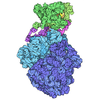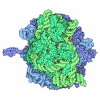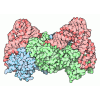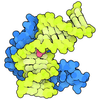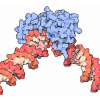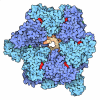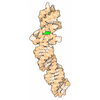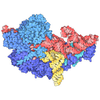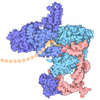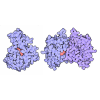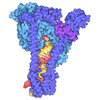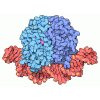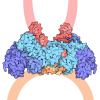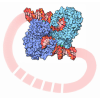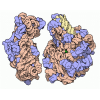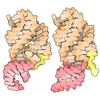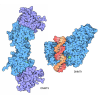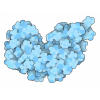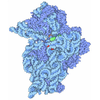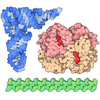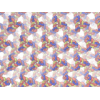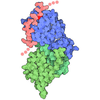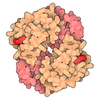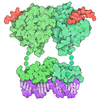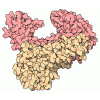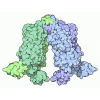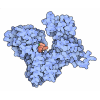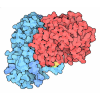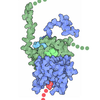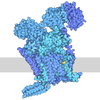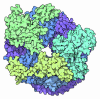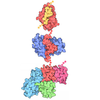+ Open data
Open data
- Basic information
Basic information
| Entry | Database: PDB / ID: 9hwg | ||||||
|---|---|---|---|---|---|---|---|
| Title | Structure of the transcribing Pol II-TCR-RECQL5 complex | ||||||
 Components Components |
| ||||||
 Keywords Keywords | TRANSCRIPTION / transcription elongation / DNA helicase / transcription-coupled repair / RNA polymerase II | ||||||
| Function / homology |  Function and homology information Function and homology informationRNA polymerase inhibitor activity / mitotic DNA-templated DNA replication / regulation of transcription-coupled nucleotide-excision repair / negative regulation of double-strand break repair via nonhomologous end joining / nucleotide-excision repair complex / chromosome separation / cellular response to camptothecin / response to auditory stimulus / four-way junction helicase activity / regulation of transcription elongation by RNA polymerase II ...RNA polymerase inhibitor activity / mitotic DNA-templated DNA replication / regulation of transcription-coupled nucleotide-excision repair / negative regulation of double-strand break repair via nonhomologous end joining / nucleotide-excision repair complex / chromosome separation / cellular response to camptothecin / response to auditory stimulus / four-way junction helicase activity / regulation of transcription elongation by RNA polymerase II / B-WICH complex / DNA protection / single strand break repair / replication-born double-strand break repair via sister chromatid exchange / Formation of RNA Pol II elongation complex / Formation of the Early Elongation Complex / Transcriptional regulation by small RNAs / RNA Polymerase II Pre-transcription Events / TP53 Regulates Transcription of DNA Repair Genes / FGFR2 alternative splicing / RNA polymerase II transcribes snRNA genes / mRNA Capping / mRNA Splicing - Minor Pathway / Processing of Capped Intron-Containing Pre-mRNA / RNA Polymerase II Promoter Escape / RNA Polymerase II Transcription Pre-Initiation And Promoter Opening / RNA Polymerase II Transcription Initiation / RNA Polymerase II Transcription Elongation / RNA Polymerase II Transcription Initiation And Promoter Clearance / RNA Pol II CTD phosphorylation and interaction with CE / Estrogen-dependent gene expression / response to superoxide / Formation of TC-NER Pre-Incision Complex / Dual incision in TC-NER / Gap-filling DNA repair synthesis and ligation in TC-NER / mRNA Splicing - Major Pathway / double-strand break repair via classical nonhomologous end joining / photoreceptor cell maintenance / chromatin-protein adaptor activity / ATP-dependent chromatin remodeler activity / positive regulation by virus of viral protein levels in host cell / spindle assembly involved in female meiosis / RNA polymerase binding / epigenetic programming in the zygotic pronuclei / positive regulation of DNA-templated transcription, elongation / response to UV-B / nuclear lumen / UV-damage excision repair / transcription preinitiation complex / positive regulation of transcription by RNA polymerase III / biological process involved in interaction with symbiont / DNA 3'-5' helicase / regulation of mitotic cell cycle phase transition / DNA metabolic process / WD40-repeat domain binding / ATP-dependent DNA damage sensor activity / 3'-5' DNA helicase activity / Cul4A-RING E3 ubiquitin ligase complex / Cul4-RING E3 ubiquitin ligase complex / Cul4B-RING E3 ubiquitin ligase complex / ubiquitin ligase complex scaffold activity / positive regulation of transcription by RNA polymerase I / negative regulation of reproductive process / RNA polymerase II complex binding / negative regulation of developmental process / protein tyrosine kinase activator activity / maintenance of transcriptional fidelity during transcription elongation by RNA polymerase II / RNA Polymerase I Transcription Initiation / site of DNA damage / viral release from host cell / cullin family protein binding / negative regulation of transcription elongation by RNA polymerase II / pyrimidine dimer repair / response to X-ray / positive regulation of transcription initiation by RNA polymerase II / ATP-dependent activity, acting on DNA / translation elongation factor activity / ectopic germ cell programmed cell death / negative regulation of double-strand break repair via homologous recombination / RNA polymerase I complex / transcription elongation by RNA polymerase I / RNA polymerase III complex / ubiquitin-like ligase-substrate adaptor activity / positive regulation of viral genome replication / response to UV / RNA polymerase II, core complex / tRNA transcription by RNA polymerase III / positive regulation of double-strand break repair via homologous recombination / protein autoubiquitination / proteasomal protein catabolic process / transcription by RNA polymerase I / JNK cascade / neurogenesis / transcription-coupled nucleotide-excision repair / positive regulation of gluconeogenesis / DNA-directed RNA polymerase complex / DNA helicase activity / positive regulation of DNA repair / DNA damage checkpoint signaling / replication fork Similarity search - Function | ||||||
| Biological species |  Homo sapiens (human) Homo sapiens (human) synthetic construct (others) | ||||||
| Method | ELECTRON MICROSCOPY / single particle reconstruction / cryo EM / Resolution: 3.5 Å | ||||||
 Authors Authors | Zhang, L. / Zhang, S. | ||||||
| Funding support |  United Kingdom, 1items United Kingdom, 1items
| ||||||
 Citation Citation |  Journal: Nat Struct Mol Biol / Year: 2025 Journal: Nat Struct Mol Biol / Year: 2025Title: Structural basis of RECQL5-induced RNA polymerase II transcription braking and subsequent reactivation. Authors: Luojia Zhang / Yuliya Gordiyenko / Tomos Morgan / Catarina Franco / Ana Tufegdžić Vidaković / Suyang Zhang /  Abstract: Abnormally fast transcription elongation can lead to detrimental consequences such as transcription-replication collisions, altered alternative splicing patterns and genome instability. Therefore, ...Abnormally fast transcription elongation can lead to detrimental consequences such as transcription-replication collisions, altered alternative splicing patterns and genome instability. Therefore, elongating RNA polymerase II (Pol II) requires mechanisms to slow its progression, yet the molecular basis of transcription braking remains unclear. RECQL5 is a DNA helicase that functions as a general elongation factor by slowing down Pol II. Here we report cryo-electron microscopy structures of human RECQL5 bound to multiple transcription elongation complexes. Combined with biochemical analysis, we identify an α-helix of RECQL5 responsible for binding Pol II and slowdown of transcription elongation. We further reveal that the transcription-coupled DNA repair (TCR) complex allows Pol II to overcome RECQL5-induced transcription braking through concerted actions of its translocase activity and competition with RECQL5 for engaging Pol II. Additionally, RECQL5 inhibits TCR-mediated Pol II ubiquitination to prevent activation of the DNA repair pathway. Our results suggest a model in which RECQL5 and the TCR complex coordinately regulate transcription elongation rates to ensure transcription efficiency while maintaining genome stability. | ||||||
| History |
|
- Structure visualization
Structure visualization
| Structure viewer | Molecule:  Molmil Molmil Jmol/JSmol Jmol/JSmol |
|---|
- Downloads & links
Downloads & links
- Download
Download
| PDBx/mmCIF format |  9hwg.cif.gz 9hwg.cif.gz | 1.2 MB | Display |  PDBx/mmCIF format PDBx/mmCIF format |
|---|---|---|---|---|
| PDB format |  pdb9hwg.ent.gz pdb9hwg.ent.gz | 936.2 KB | Display |  PDB format PDB format |
| PDBx/mmJSON format |  9hwg.json.gz 9hwg.json.gz | Tree view |  PDBx/mmJSON format PDBx/mmJSON format | |
| Others |  Other downloads Other downloads |
-Validation report
| Summary document |  9hwg_validation.pdf.gz 9hwg_validation.pdf.gz | 1.8 MB | Display |  wwPDB validaton report wwPDB validaton report |
|---|---|---|---|---|
| Full document |  9hwg_full_validation.pdf.gz 9hwg_full_validation.pdf.gz | 1.9 MB | Display | |
| Data in XML |  9hwg_validation.xml.gz 9hwg_validation.xml.gz | 172.2 KB | Display | |
| Data in CIF |  9hwg_validation.cif.gz 9hwg_validation.cif.gz | 269.1 KB | Display | |
| Arichive directory |  https://data.pdbj.org/pub/pdb/validation_reports/hw/9hwg https://data.pdbj.org/pub/pdb/validation_reports/hw/9hwg ftp://data.pdbj.org/pub/pdb/validation_reports/hw/9hwg ftp://data.pdbj.org/pub/pdb/validation_reports/hw/9hwg | HTTPS FTP |
-Related structure data
| Related structure data |  52449MC  9hvoC  9hvqC M: map data used to model this data C: citing same article ( |
|---|---|
| Similar structure data | Similarity search - Function & homology  F&H Search F&H Search |
- Links
Links
- Assembly
Assembly
| Deposited unit | 
|
|---|---|
| 1 |
|
- Components
Components
-DNA-directed RNA polymerase ... , 7 types, 7 molecules ABCEGIK
| #1: Protein | Mass: 217450.078 Da / Num. of mol.: 1 / Source method: isolated from a natural source / Source: (natural)  References: UniProt: A0A8D1DPV6, DNA-directed RNA polymerase |
|---|---|
| #2: Protein | Mass: 134041.422 Da / Num. of mol.: 1 / Source method: isolated from a natural source / Source: (natural)  References: UniProt: A0A0B8RVL1, DNA-directed RNA polymerase |
| #3: Protein | Mass: 31439.074 Da / Num. of mol.: 1 / Source method: isolated from a natural source / Source: (natural)  |
| #5: Protein | Mass: 24644.318 Da / Num. of mol.: 1 / Source method: isolated from a natural source / Source: (natural)  |
| #7: Protein | Mass: 19314.283 Da / Num. of mol.: 1 / Source method: isolated from a natural source / Source: (natural)  |
| #9: Protein | Mass: 14541.221 Da / Num. of mol.: 1 / Source method: isolated from a natural source / Source: (natural)  |
| #11: Protein | Mass: 13310.284 Da / Num. of mol.: 1 / Source method: isolated from a natural source / Source: (natural)  |
-RNA polymerase ... , 2 types, 2 molecules DL
| #4: Protein | Mass: 16331.255 Da / Num. of mol.: 1 / Source method: isolated from a natural source / Source: (natural)  |
|---|---|
| #12: Protein | Mass: 7018.244 Da / Num. of mol.: 1 / Source method: isolated from a natural source / Source: (natural)  |
-DNA-directed RNA polymerases I, II, and III subunit ... , 3 types, 3 molecules FHJ
| #6: Protein | Mass: 14477.001 Da / Num. of mol.: 1 / Source method: isolated from a natural source / Source: (natural)  |
|---|---|
| #8: Protein | Mass: 17162.273 Da / Num. of mol.: 1 / Source method: isolated from a natural source / Source: (natural)  |
| #10: Protein | Mass: 7655.123 Da / Num. of mol.: 1 / Source method: isolated from a natural source / Source: (natural)  |
-DNA chain , 2 types, 2 molecules NT
| #13: DNA chain | Mass: 14494.314 Da / Num. of mol.: 1 / Source method: obtained synthetically / Source: (synth.) synthetic construct (others) |
|---|---|
| #16: DNA chain | Mass: 14269.129 Da / Num. of mol.: 1 / Source method: obtained synthetically / Source: (synth.) synthetic construct (others) |
-Protein , 4 types, 4 molecules Ocde
| #14: Protein | Mass: 109024.859 Da / Num. of mol.: 1 Source method: isolated from a genetically manipulated source Source: (gene. exp.)  Homo sapiens (human) / Gene: RECQL5, RECQ5 / Production host: Homo sapiens (human) / Gene: RECQL5, RECQ5 / Production host:  Trichoplusia ni (cabbage looper) / References: UniProt: O94762, DNA 3'-5' helicase Trichoplusia ni (cabbage looper) / References: UniProt: O94762, DNA 3'-5' helicase |
|---|---|
| #19: Protein | Mass: 80721.680 Da / Num. of mol.: 1 Source method: isolated from a genetically manipulated source Source: (gene. exp.)  Homo sapiens (human) / Gene: UVSSA, KIAA1530 / Production host: Homo sapiens (human) / Gene: UVSSA, KIAA1530 / Production host:  Trichoplusia ni (cabbage looper) / References: UniProt: Q2YD98 Trichoplusia ni (cabbage looper) / References: UniProt: Q2YD98 |
| #20: Protein | Mass: 127097.469 Da / Num. of mol.: 1 Source method: isolated from a genetically manipulated source Source: (gene. exp.)  Homo sapiens (human) / Gene: DDB1, XAP1 / Production host: Homo sapiens (human) / Gene: DDB1, XAP1 / Production host:  Trichoplusia ni (cabbage looper) / References: UniProt: Q16531 Trichoplusia ni (cabbage looper) / References: UniProt: Q16531 |
| #21: Protein | Mass: 9475.881 Da / Num. of mol.: 1 Source method: isolated from a genetically manipulated source Source: (gene. exp.)  Homo sapiens (human) / Gene: ELOF1, hCG_29982 / Production host: Homo sapiens (human) / Gene: ELOF1, hCG_29982 / Production host:  Trichoplusia ni (cabbage looper) / References: UniProt: A0A024R7E8 Trichoplusia ni (cabbage looper) / References: UniProt: A0A024R7E8 |
-RNA chain , 1 types, 1 molecules P
| #15: RNA chain | Mass: 14490.756 Da / Num. of mol.: 1 / Source method: obtained synthetically / Source: (synth.) synthetic construct (others) |
|---|
-DNA excision repair protein ERCC- ... , 2 types, 2 molecules ab
| #17: Protein | Mass: 44107.160 Da / Num. of mol.: 1 Source method: isolated from a genetically manipulated source Source: (gene. exp.)  Homo sapiens (human) / Gene: ERCC8, CKN1, CSA / Production host: Homo sapiens (human) / Gene: ERCC8, CKN1, CSA / Production host:  Trichoplusia ni (cabbage looper) / References: UniProt: Q13216 Trichoplusia ni (cabbage looper) / References: UniProt: Q13216 |
|---|---|
| #18: Protein | Mass: 168673.547 Da / Num. of mol.: 1 Source method: isolated from a genetically manipulated source Source: (gene. exp.)  Homo sapiens (human) / Gene: ERCC6, CSB / Production host: Homo sapiens (human) / Gene: ERCC6, CSB / Production host:  Trichoplusia ni (cabbage looper) Trichoplusia ni (cabbage looper)References: UniProt: Q03468, Hydrolases; Acting on acid anhydrides; Acting on acid anhydrides to facilitate cellular and subcellular movement |
-Non-polymers , 2 types, 12 molecules 


| #22: Chemical | ChemComp-ZN / #23: Chemical | |
|---|
-Details
| Has ligand of interest | N |
|---|---|
| Has protein modification | Y |
-Experimental details
-Experiment
| Experiment | Method: ELECTRON MICROSCOPY |
|---|---|
| EM experiment | Aggregation state: PARTICLE / 3D reconstruction method: single particle reconstruction |
- Sample preparation
Sample preparation
| Component | Name: PolII-TCR-RECQL5 complex / Type: COMPLEX / Entity ID: #1-#21 / Source: RECOMBINANT |
|---|---|
| Source (natural) | Organism:  Homo sapiens (human) Homo sapiens (human) |
| Source (recombinant) | Organism:  Trichoplusia ni (cabbage looper) Trichoplusia ni (cabbage looper) |
| Buffer solution | pH: 7.5 Details: 20 mM HEPES pH 7.5, 50 mM KCl, 4 mM MgCl2, 1 mM DTT |
| Specimen | Embedding applied: NO / Shadowing applied: NO / Staining applied: NO / Vitrification applied: YES |
| Specimen support | Grid material: COPPER / Grid mesh size: 200 divisions/in. / Grid type: Quantifoil R3.5/1 |
| Vitrification | Instrument: FEI VITROBOT MARK IV / Cryogen name: ETHANE / Humidity: 100 % |
- Electron microscopy imaging
Electron microscopy imaging
| Experimental equipment |  Model: Titan Krios / Image courtesy: FEI Company |
|---|---|
| Microscopy | Model: TFS KRIOS |
| Electron gun | Electron source:  FIELD EMISSION GUN / Accelerating voltage: 300 kV / Illumination mode: FLOOD BEAM FIELD EMISSION GUN / Accelerating voltage: 300 kV / Illumination mode: FLOOD BEAM |
| Electron lens | Mode: BRIGHT FIELD / Nominal magnification: 96000 X / Nominal defocus max: 2500 nm / Nominal defocus min: 500 nm / Cs: 2.7 mm / C2 aperture diameter: 50 µm |
| Specimen holder | Cryogen: NITROGEN / Specimen holder model: FEI TITAN KRIOS AUTOGRID HOLDER |
| Image recording | Electron dose: 36.6 e/Å2 / Film or detector model: FEI FALCON IV (4k x 4k) / Num. of grids imaged: 1 |
- Processing
Processing
| EM software | Name: PHENIX / Version: 1.21.2_5419: / Category: model refinement |
|---|---|
| CTF correction | Type: PHASE FLIPPING AND AMPLITUDE CORRECTION |
| 3D reconstruction | Resolution: 3.5 Å / Resolution method: FSC 0.143 CUT-OFF / Num. of particles: 19458 / Num. of class averages: 1 / Symmetry type: POINT |
 Movie
Movie Controller
Controller







 PDBj
PDBj